Friday
Arts and PoetryDharma Art and the Yearly Festivals
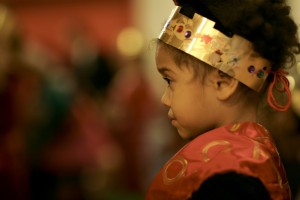 by the Dharma Art Guild of New York
by the Dharma Art Guild of New York
Jack Niland, Allison Pepper, Andrew Forbes, and Andi Nyiradi
article edited by Andrew Forbes
photos by Caitlin Strom
The basic elements of cultural importance are the preservation of traditional ceremonies, rituals and festivals. As we can see in living traditions today, like the Olympics, the ceremonies of lighting the torch and parading the global nationalities galvanize the spirit of the whole planet, a universal sensation of sacredness and global citizenship. The hallmark of tradition is the implementation of yearly festivals and the specific folklore, mythology, dance and music associated with that particular festival. We see it in the most conventional festivals that are celebrated yearly: Christmas, Easter, Midsummer’s day, Thanksgiving, Halloween. These keep our tradition, that of being 21st century Americans, alive. So much depends on the stabilization and integrity of these celebrations because it governs many of the choices that we make throughout our lives.
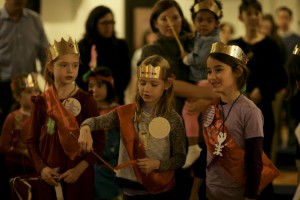 In Shambhala, the Vidyadhara, Chogyam Trungpa Rinpoche saw the importance of creating a culture that supports the contemplative tradition. In America many people feel disinherited. They cannot trace a familial lineage more than five generations, and do not feel like they are a part of a community that extends farther than their personal life. He saw that the greatest civilizations the world has ever seen are remembered most commonly not by their contributions to science or humanities, but by their folklore and art. In creating a culture around his importation of Buddhism, festivals and holidays were introduced to strengthen community. Midsummer’s Day, Children’s Day, Shambhala Day, and the Harvest of Peace are the major yearly traditions we have to generate this culture of contemplative society. These holidays directly correlate with the eight Celtic holidays and the lunar calendar.
In Shambhala, the Vidyadhara, Chogyam Trungpa Rinpoche saw the importance of creating a culture that supports the contemplative tradition. In America many people feel disinherited. They cannot trace a familial lineage more than five generations, and do not feel like they are a part of a community that extends farther than their personal life. He saw that the greatest civilizations the world has ever seen are remembered most commonly not by their contributions to science or humanities, but by their folklore and art. In creating a culture around his importation of Buddhism, festivals and holidays were introduced to strengthen community. Midsummer’s Day, Children’s Day, Shambhala Day, and the Harvest of Peace are the major yearly traditions we have to generate this culture of contemplative society. These holidays directly correlate with the eight Celtic holidays and the lunar calendar.
 The Children’s day celebration is the most important of these celebrations as it is the opportunity to introduce the essence of Shambhala culture to children, who may have never encountered these principles before. In major city centers in the Shambhala mandala, people go to great lengths to produce amateur plays that present Shambhalian stories to youngsters, from Walter Fordham’s Iliyana to Gesar stories, to tales of Prince Shotoku Taishi. This year in New York City, a small troupe of dharma artists composed a play to present at this year’s Children’s Day event, the largest Children’s day in New York sangha history. Under the tutelage of Jack Niland, a group of young adults composed a play specifically for this Children’s day celebration. Drawn from tantric practice, the eight Celtic holidays, and the Shambhala dharma, the story is an opportunity for children (and adults) to enter a world of imagination to discover their own inherent dignity.
The Children’s day celebration is the most important of these celebrations as it is the opportunity to introduce the essence of Shambhala culture to children, who may have never encountered these principles before. In major city centers in the Shambhala mandala, people go to great lengths to produce amateur plays that present Shambhalian stories to youngsters, from Walter Fordham’s Iliyana to Gesar stories, to tales of Prince Shotoku Taishi. This year in New York City, a small troupe of dharma artists composed a play to present at this year’s Children’s Day event, the largest Children’s day in New York sangha history. Under the tutelage of Jack Niland, a group of young adults composed a play specifically for this Children’s day celebration. Drawn from tantric practice, the eight Celtic holidays, and the Shambhala dharma, the story is an opportunity for children (and adults) to enter a world of imagination to discover their own inherent dignity.
Following the lead of the hero’s journey, with the spirit of a children’s story, the play begins with the premise of a young heroine, a Little Girl. In an audience with the King and Queen of Shambhala, she is assigned a mission to find the magical golden key, lost to the royal family and needed to open the treasure chest which holds the magic mirror, needed to create the new golden age. She is given a scroll containing a riddle, which reads:
A treasure hidden
Demands a secret key
A magic mirror reflects
Truth in all we can see
The lock is bound by doubtful thought
The key is held by those who cross
The borders of imagination
To see the world as pure creation.
Unborn, unknown but always awake,
Open your heart and unlock the gate.
Ki Ki So So
The Little Girl is told by the King that this scroll will help her when she reaches a point in her journey where all hope is lost. After singing the song “We are the Warriors,” she begins her journey through the Forest of Fear, a dark and scary forest full of dangerous animals and treacherous terrain. Not long after embarking on the trail she runs in the Green Man, who tries to scare her by telling her to get out of his forest. Immediately a Tiger appears and tells her not be scared but to take her seat instead, and in doing so the Green Man’s anger is exacerbated and he runs away. She is then rewarded with a sash to remind her of her empowerment.
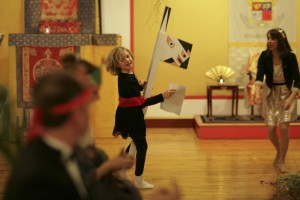 As she continues on the journey, she is confronted by the Green Man again and again, but each time he appears the Lion, Garuda and Dragon all appear to encourage her bravery and overcome the Green Man. They each reward her with accoutrements of a wand, a regalia pin, and a crown (all the children have already been given these accoutrements and are wearing them). When she reaches the end of the Forest of Fears she is lost and loses all hope. She opens the scroll and reads it again, and contemplating the riddle, she realizes that she has the golden key in her heart. She then realizes that everyone has this golden key, and so the Queen and King must have it too!
As she continues on the journey, she is confronted by the Green Man again and again, but each time he appears the Lion, Garuda and Dragon all appear to encourage her bravery and overcome the Green Man. They each reward her with accoutrements of a wand, a regalia pin, and a crown (all the children have already been given these accoutrements and are wearing them). When she reaches the end of the Forest of Fears she is lost and loses all hope. She opens the scroll and reads it again, and contemplating the riddle, she realizes that she has the golden key in her heart. She then realizes that everyone has this golden key, and so the Queen and King must have it too!
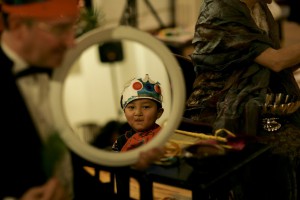 She can’t possibly make it back in time for the sunrise after having traveled so far. When she utters Ki Ki So So, suddenly a magical windhorse unicorn appears. Jumping on the back of the windhorse, she cries out Ki Ki So So and flies to the royal palace, landing in front of the King and Queen. Telling them about her discovery, they are overjoyed and use the magical golden key to open the treasure box to reveal the magic mirror. Then there is a mirror/juniper blessing for all the children in the assembly.
She can’t possibly make it back in time for the sunrise after having traveled so far. When she utters Ki Ki So So, suddenly a magical windhorse unicorn appears. Jumping on the back of the windhorse, she cries out Ki Ki So So and flies to the royal palace, landing in front of the King and Queen. Telling them about her discovery, they are overjoyed and use the magical golden key to open the treasure box to reveal the magic mirror. Then there is a mirror/juniper blessing for all the children in the assembly.
Although the story resembles many different tales in the Shambhala and Buddhist traditions, it is essentially the entire path of warriorship condensed into a single performance, allowing the children to experience the profundity of self-visualization by stepping into a world of imagination.
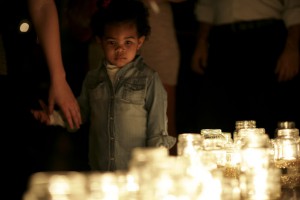 The essence of Dharma Art is the Dzogchen approach, displaying the complete tradition in one gesture. This is at the heart of Chogyam Trungpa’s teaching, and looking back upon his influence and life, we see that he was constantly creating environments that allowed people to embellish their imagination: seeing themselves and their world as sacred rather than profane, and effectively creating a sacred world in which they could experience their own basic goodness. By understanding the methods of creation and completion, we learn that we can live in a world in which we can always appreciate sacred outlook.
The essence of Dharma Art is the Dzogchen approach, displaying the complete tradition in one gesture. This is at the heart of Chogyam Trungpa’s teaching, and looking back upon his influence and life, we see that he was constantly creating environments that allowed people to embellish their imagination: seeing themselves and their world as sacred rather than profane, and effectively creating a sacred world in which they could experience their own basic goodness. By understanding the methods of creation and completion, we learn that we can live in a world in which we can always appreciate sacred outlook.
 By understanding the universal way – the Tao, we find that dharma art not only applies to personal projects, but to understanding astrology, the nature of festivals and holidays, folklore, mythology, and the stories that are laden in each holiday of the year. By understanding these stories, which are preserved in the ancient Celtic traditions (for which Chogyam Trungpa had an appreciation) we can find a living interpretation of these holidays, and thereby understand how these holidays are relevant in cultivating enlightened society.
By understanding the universal way – the Tao, we find that dharma art not only applies to personal projects, but to understanding astrology, the nature of festivals and holidays, folklore, mythology, and the stories that are laden in each holiday of the year. By understanding these stories, which are preserved in the ancient Celtic traditions (for which Chogyam Trungpa had an appreciation) we can find a living interpretation of these holidays, and thereby understand how these holidays are relevant in cultivating enlightened society.
The heart of transforming society is revitalizing the traditions and holidays that represent the essence of human dignity. These traditions have been suppressed by theistic religions for centuries, but by reintroducing them, people can understand the magic of the world once again, finding their place as empowered global citizens, rather than displaced despots in a phenomenal wasteland.

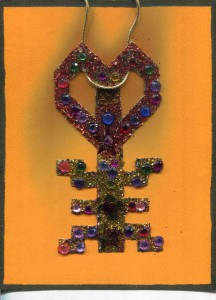
















Mar 12, 2013
Reply
Wow! Thank you to Jack, Alison, Andrew and Andi for launching this wonderful play, and to the NYC sangha for having their biggest Children’s Day celebration ever. It sounds like so much fun. It’s a great example to see how many people can be inspired when we enrich our holiday celebrations. Thank you!
Mar 11, 2013
Reply
ASLEEP AND AWAKE
While the grass was falling asleep
Waiting for the snowflakes,
Timid world has been reshaped into warrior world:
My accomplishment is achieved.
Abundance of sympathy, devotion, kindness, politeness–
All amount to asleep and awake.
When dying culture is reintroduced,
It becomes genuinely powerful.
CTR, 11 February 1977